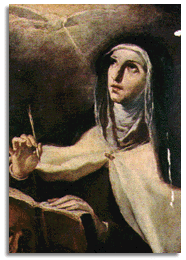I will head for
the mountains
and for watersides;
I will not gather flowers,
nor fear wild beasts;
I will go beyond
strong men
and frontiers.
Spiritual Canticle, Stanza 3
by St. John of the Cross
The Community of Discalced Carmelite Nuns of San Antonio, Texas
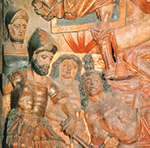
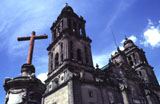
In the planning stages Bishop Zubiría had visited the original community of Mexico City to ask for their help. One of the Nuns, Sister Maria Josefa Catalina de Jesús, showed great interest in the new foundation.
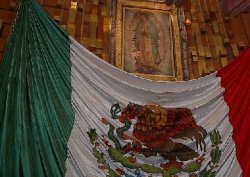

About a mile north of the city of Durango, at the Church of Santa Ana, the Sisters were led in a solemn procession by all the religious and civil leaders of Durango, along with a large crowd of its citizens, to the Cathedral of Durango. Once they arrived at the Cathedral, the bells of all the churches began to ring. The community was ushered to the front of the Cathedral, where the Blessed Sacrament was exposed and an orchestra played. After a warm welcome and homily delivered by Archbishop Zubiria, and followed by a blessing given with the Blessed Sacrament the Sisters were led with music from a military band and candle light, to their new home. The monastery bore the title of Our Lady of Guadalupe, the enclosure was put into effect on June 26, 1853 and the Blessed Sacrament was placed in their chapel on the 2nd of July. During the first three years 13 new vocations entered, and the community prospered.
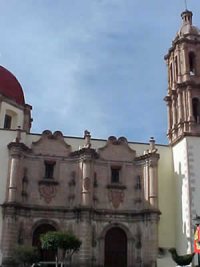
Church of St. Anne in Durango
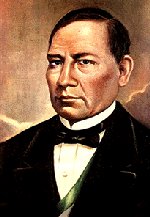
Juarez
Our community, which now numbered 21, was able to continue its religious life until 1864, primarily because the people of Durango were overjoyed at having the sisters in their city. Finally however, they were forced to leave their monastery. The Nuns found refuge in several homes in that city. After a few years , they were able to return to their monastery, as the anti - religious sentiment had somewhat subsided . However, they lived in constant fear of further denunciations and exclaustration. Problems were enhanced because they were prohibited from receiving new vocations, many of the Sisters were quite advanced in age, and several of the original community had died.
A number of years later the nuns were again exclaustrated by the government. The community once more divided itself into small groups hiding in private homes. This situation continued until 1900, when the Archbishop of Durango, seeing that there were only two of the Carmelite Nuns still living, and not wanting the community to die out, asked for more Nuns from the original founding community of Mexico City.
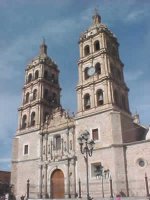
Cathedral of Durango

Durango, Mexico ![]()
However, time was quickly passing, and there now remained only one sister in Durango from the original foundation, Sister Angustias, and she was reaching an advanced age. Seeing that the only obstacle that kept the re-foundation from being made was the foundation of the Friars in Durango, Sister Magdalena had a strategy. She wrote a letter using the words and style of our Holy Mother, St. Teresa when she wrote to the King of Spain, Philip the II. After praying to St. Teresa to intercede for her, she put the letter into the hands of a much venerated statue of St.Teresa. The statue carrying the letter in its hand was then taken to the Archbishop of Durango's residence. Ever since the Archbishop was a child he had kept a great devotion to St. Teresa, and to this particular image of her. Upon seeing the statue and reading the letter, he was greatly moved, and gave his approval of the founding of the Fathers when the Nuns returned to Durango.
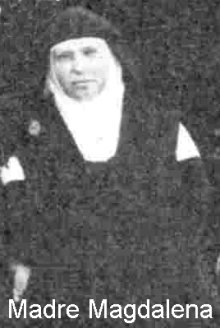
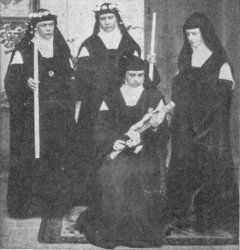
On December 29, 1901, four Nuns came to Durango to join Sister Angustias, the only surviving member of the original community. Three Discalced Carmelite Friars, who had come to make the Father's foundation of their own new monastery, accompanied the Sisters. The Nuns went directly to a house donated to them as a convent. The Fathers went to the home of a diocesan priest who assisted the Friars in their beginnings.
In March of 1917, the Mexican Government made another demand that the Nuns abandon their monastery without taking anything from it. One evening, soldiers forced their way into the enclosure of the monastery. Mother Magdalena ran to the chapel and took out the ciborium, hiding it under her scapular. Then she hid behind a curtain with several other Sisters as the soldier passed by. Once the soldiers had gone to another part of their convent, Mother Magdalena, and the Sisters with her, consumed the Blessed Sacrament, and then ran out of the monastery, only to find themselves surrounded by more soldiers. The soldiers then disbanded the community, and each of the Nuns went to find refuge in the homes of friends in the city. Mother Magdalena was extremely concerned for her Nuns, not knowing where they were all hiding, and whether or not all had left the monastery. It was days before she found them all well and safe. A few soldiers were left to take over the convent. Four Sisters had not been able to get out of the convent with the rest of the Nuns, and were being held there by the soldiers for questioning.
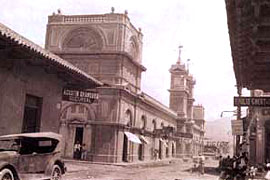
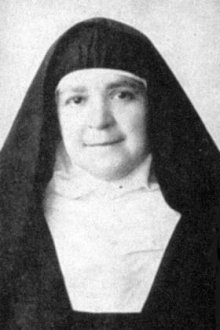
Sr. Maria de los Angeles
Finally, all four were freed and were reunited with the rest of the community. The Sisters continued to hide in small groups, in houses of friends and family. The government officials looked for them to force them to hand over the money the community had to live on. For a while the community was able to stay together, and found shelter hiding in the Church of the Angels. They helped clean and care for the church. Soon, however, the Nuns were once again denounced and had to hide in homes of friends and relatives once more, unable to live in community.
Knowing that some things were being sold from their convent, the Sisters tried to find ways of recuperating what they could, especially their Breviaries, as they had nothing from which to pray the Divine Office. Two Sisters, dressed in secular clothing, went to their convent with two lady friends and began rummaging through merchandise the soldiers were selling. They told the soldiers that they were teachers of Latin, and wanted to see what books they could find which would be suitable for their students. As they were led through the convent to the library, they saw statues broken on the floor, relics walked on, the tabernacle desecrated, papers and altar linens thrown on the floor, and crucifixes and the statue of Infant of Prague thrown into the horses stalls and manure. Even though they greatly feared being recognized, and suffering the anguish of seeing the state of their monastery and possessions, these Sisters were calmly able to purchase back their liturgical books, breviaries, and the statue of the Infant of Prague. This statue is now venerated in a special niche in our chapel in San Antonio.
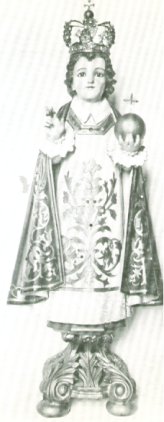
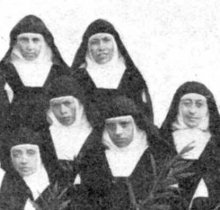
In May of this same year, seven robbers came one night at 2:00 a.m., rang the doorbell, and pretended to be helping the Nun's gardener, who, they said, had been bitten by a snake. They tricked Sister Maria del Santisimo into opening the door and, held a gun to her chest forcing their way into the enclosure. The other men, with rifles and knives in hand, went to the rooms of each of the Sisters and gathered them together, demanding that they surrender all they owned. The Nuns stood around Mother Magdalena, who begged the men not to insult or harm any Sister. She warned them to fear punishment from heaven. The men forced the community into a small shed in the back of their property, telling the Nuns they were going to kill them. The men locked the shed, and then went on to steal all they could carry. It was believed that the robbers were really government officials.
When day dawned, the Chaplain came to say Mass for the Sisters, and not finding them, went with several other people to look for them. They quickly found the shed where the Nuns were, and released them. Though badly shaken by the ordeal, no one was hurt. That very same day, Father Pedro de San Elias helped them find another place to live. Through all the terrors and sufferings the Sister endured during those years, the Discalced Carmelite Fathers always helped them find a solution or a way to deal with all the difficulties.
After about 3 years of relative calm, in 1926, President Calles issued a new decree stating that all religious from countries other than Mexico must return to their homeland, and all religious houses be closed. On June 6, 1926, soldiers forced their way into the chapel and convent of our Sisters. The Nuns escaped through the back door. Mother Angelita first ran to save the Blessed Sacrament from sacrilege. Taking the ciborium from the tabernacle, she hurried out the back, and struggled over the enclosure wall. Since she could not brace herself while protecting the ciborium, she fell and injured one of her feet very severely, suffering from that wound for the rest of her life. Once over the wall and safe with the other sisters, they consumed the sacred species, and then sought refuge in homes of family and friends. The Sisters could no longer turn to the Friars for assistance. The Carmelite Friars, who were mostly Spaniards, had been forced to flee from Durango as soon as the decree was issued. They went to Tucson, Arizona, where other Friars of their Province in Spain were well established. By July 22, 1926, our community of 20 religious saw that there was no alternative for them but also to flee Mexico. Crossing the border in El Paso, they headed to Tucson, Arizona. They arrived in Tucson in October. There Fr. Pedro de San Elias, Fr. Carmelo Corbello, and other Friars who had been with them in Mexico, received them and prepared a monastery for them. Bishop Daniel J. Gercke accepted them into his diocese and assisted them with great kindness.
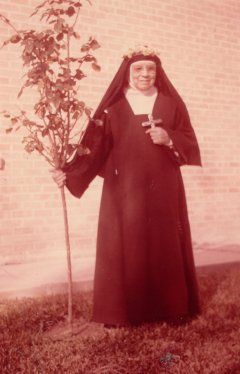
Madre Maria de San Jose

Monastery in Tuscon
Even though in hiding, and disguised, the Lord sent the community new vocations. Sister Estela del Sagrado Corazón de la Cerda, from Atotonilco, Jalisco; Sister Bernardita de la Imaculada Soriano from Huahuapan De Leon; Sister Celina de la Santa Faz Camberos from Guadalajara, and Sister Teresita Calderón (a niece of Madre Maria de San José) from Mexico City, and just before leaving to come to Texas, Sister Mary Angel Mendoza entered there.
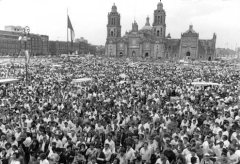
Basilica of Our Lady of Guadelupe
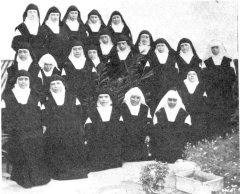
Because of advice of a friend, they came to San Antonio, Texas. The first group left by train on November 7th, 1934, and arrived on November 9th. Upon their arrival in San Antonio, the Nuns sought help from our Carmelite Fathers at the Shrine of Our Lady of Mt. Carmel and St. Therese. Surprised by their unannounced arrival the Fathers were unsure as to how to best assist the Sisters. The Prior, Fr. Bernardo Brotones, called the Provincial in Oklahoma for aid. First, lodging was sought for the Nuns, and then arrangements would be made to send the Sisters to Oklahoma where the Provincial would take care of the community's needs. The Fathers requested assistance from the Sisters of the Holy Spirit. These Sisters graciously allowed this first group to stay with them for several weeks. The second group left Mexico on November 20th and arrived on November 22nd. Father Juan Evangelista Vega, O.C.D., from the Province of Mexico, accompanied the Nuns to Laredo, doing all in his power to keep them safe. Once in Laredo, the Nuns found lodging in several different communities of religious and were again able to dress in their habits, free from fear and threats of imprisonment.
On the 24th of November, 1934, the 24 members of our community came together in a single-story house they were able to rent on the corner of Hamilton Street and Kentucky Avenue, a block away from the Father's parish of the Basilica of the National Shrine of the Little Flower.
The 1930's were difficult times for everyone here in the United States, the country was in the middle of the Great Depression. The Carmelite Fathers brought the Nuns whatever they could to help them in their efforts to become established in their new home city.
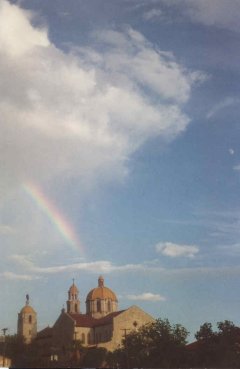
Basilica of the Little Flower
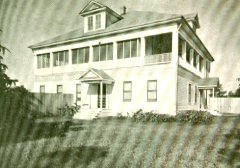
Our 1st Monastery in San Antonio, 1935
On May 17, 1935, this large house was blessed and the Nuns moved in. At last the community was able to begin a normal life again. The effects of poverty were great, the Sisters worked into the late hours of the night, barely able to raise the funds needed for their livelihood. The people of the San Antonio area were most kind and generous. Many neighbors, along with the Fathers, brought the Nuns food. When the community's water was cut off because they could not afford to pay the bill, a neighbor from behind the monastery would put a hose over the enclosure wall and turn on the water when needed. The Nuns, even though experiencing such extremes of poverty, were very happy. For the first time, almost since their foundation, they were able to live in freedom and security.
This monastery was completed, and blessed on July 16, 1950 by the Provincial, Father Sebastian Valles, O.C.D.
The Centennial Year of our Foundation was in 1953, one hundred years from our beginnings in Durango. To commemorate the event the community made the decision to begin a new foundation. Permission was granted to establish a new convent in Houston, Texas. In 1958, six of our Sisters left San Antonio to begin the foundation there, at first in a small house. In 1970, they were able to build a new monastery in Roman Forest, just outside of Houston, where they are now well established.
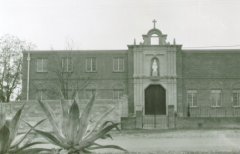
Monastery on Kentucy Ave. - 1950

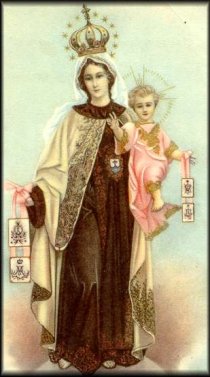
Another three years passed, and at last, on July 16th 1986, the chapel and monastery were finished and dedicated by Archbishop Patrick Flores. In a Mass concelebrated with Fr Ralph Reyes, O.C.D. (Provincial at the time), many of the Discalced Carmelite Fathers our Province of St. Therese, and large number of the Diocesan clergy. Our Carmelite Brothers and many friends also attended.
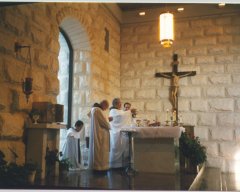
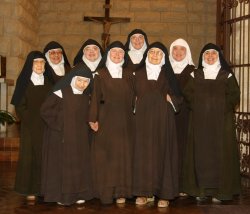
consecrated life of prayer,
we give all we are to the
glory of God for the good
of the Church, especially the
Church of San Antonio. To
the Infant of Prague, the
Eternal Word who enters
our world in selfless giving,
and to our Lady of
Guadalupe, our Mother, we
entrust all we have been and
hope to become. May all
who come to this House of
Prayer experience the
presence of God in all that
touches their lives.
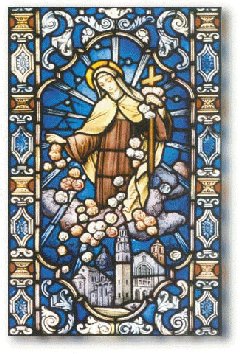
|
Home .
Guestbook .
Prayer Requests .
Ponderings
|
